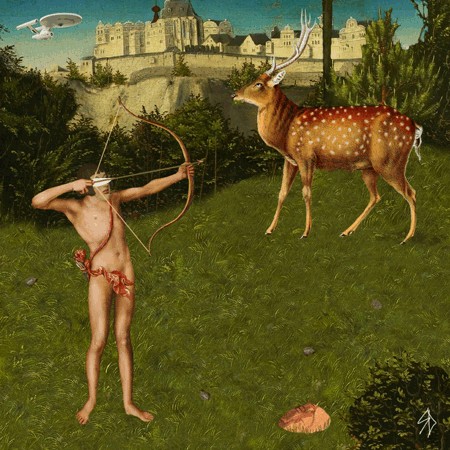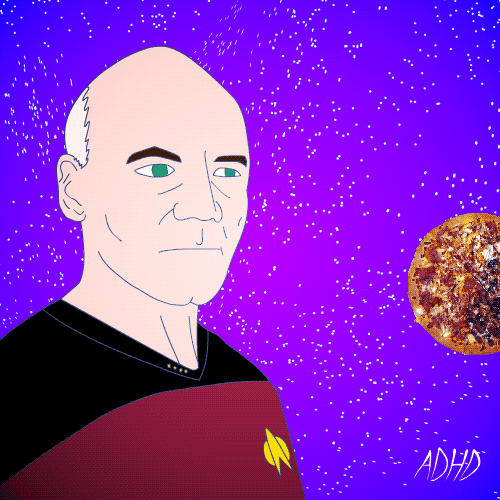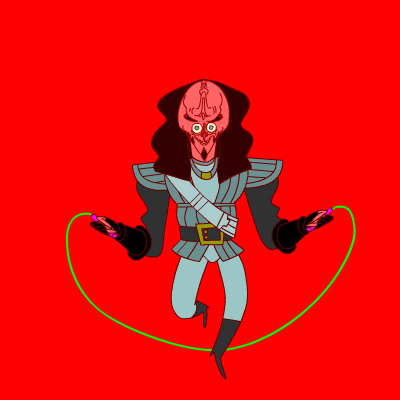Rolandt
Shared posts
Learn JavaScript promises in ~70 minutes?
Transport Canada safety advisory informs Canadians not to use the Galaxy Note 7 on planes
Samsung’s Galaxy Note 7 is one of the most beautiful smartphones ever produced. Unfortunately, however, the flagship device suffers from major issues and in some cases can actually catch fire.
Following a global recall, Transport Canada has echoed the same statement as the U.S. Federal Aviation Administration by informing passengers to avoid using or charging the Note 7 while on board a flight.
“Transport Canada is advising air operators, passengers and crew of this safety risk and recommends that Samsung Galaxy Note 7 devices be carried in the cabin, where an incident can be immediately mitigated, and not in checked baggage. Transport Canada also strongly recommends against using or charging these devices in the cabin of an aircraft,” said Transport Canada in a release.
Air Canada and Porter Airlines have both followed guidelines by Transport Canada, noting an alert on their websites.
“Air Canada advises passengers to follow Transport Canada’s recommendations not to turn on or charge their Samsung Galaxy Note 7 devices on board aircraft, and not to stow them in checked baggage.”
Samsung pulled the 5.7-inch Note 7 from all retail channels on September 2nd, noting 35 cases of the device exploding and causing damage. In total, Samsung sold 2.5 million units and is reportedly planning to continue sales later this month.
According to Samsung, the reason for the battery bursting into flames is “an issue with the battery cell. An overheating of the battery cell occurred when the anode-to-cathode came into contact which is a very rare manufacturing process error.”
Granville Island 2040
Photo by Alyson Hurt on Flickr
I went this morning to a workshop called “Getting to and Moving Through Granville Island”. It is part of Granville Island 2040, “a planning initiative that will set out a comprehensive direction and dynamic vision for the island’s future” organised by CMHC and Granville Island. The session, facilitated by Bunt & Associates, collaboratively reviewed current infrastructure, mobility services and travel patterns as well as seeking ideas and opinions on critical transportation elements for the Island’s future. It was a group of about 20 “stakeholders” which included local residents’ associations, City of Vancouver staff, Translink, both of the ferry companies, the local business association, BEST, Modacity and Ocean concrete.
There had been a meeting the previous day dealing with land use, and there will be many more opportunities for people who are interested to get involved. You can even Instagram your idea with the hashtag #GI2040 – which I have already done. But there’s a lot more to this idea that I want to write about.
First of all I think it is very unfortunate that the process separates out transportation and land use, since I am convinced that these must be considered together: they are two sides of the same coin. Secondly the process centres around the vision for what people want to see by in 2040, and then there will be thought about how to achieve that. I think it is immediately apparent that CMHC has its own process for deciding how to replace Emily Carr University when it relocates to False Creek Flats. This long term vision has to assume that it sorted out, and that CMHC has achieved its own objective of seeing increased levels of activity on the Island.
The workshop started with a presentation by Bunt & Associates of some recent transportation data they have collected last month, compared to data collected on the same days in August 2005. I did not take notes, thinking that there might be a handout or perhaps material on the website. So I am forced to summarise the findings without any of the figures in front of me. There has been an increase in the number of people going to the Island, but a drop in the number of cars. The increases come from increased use of the ferries, pedestrians and cycling. They conducted cordon counts between noon and 6pm midweek and a Saturday and a very limited interview survey, to help identify where people came from, how many were in the group and how much they spent. Car occupancy has increased. The Island is now also on the itinerary of the Hop-on/Hop-off service which wasn’t the case ten years ago.
There were some very obvious weaknesses in the data. For instance, transit passengers were only counted at the cordon when they got off the #50 bus. It is my observation that many people walking into Granville Island have come from the bus stops at the southern end of Granville Bridge. While some of that “multi-mode” travel is apparent from the interview survey, it is not like a trip diary. There were also no counts in the evenings, when the use of Granville Island shifts considerably to the theatres and destination restaurants like Bridges and Sandbar.
There were the usual workshop activities of putting sticky notes on maps and talking in breakout groups, and some of the common ground was apparent early on. Reuse of the abandoned Historic Railway to connect to the mostly empty parking lots and Olympic Village station, for instance. By 2040 that may even extend to the tram envisioned for the Arbutus Corridor, and even if that can’t be achieved by then, the Greenway linkage to the Seawall was a favourite too. Currently while pedestrians and bikes have a few options, vehicles have only one, and I am relieved to report that no-one thought there should be more. In fact the traffic count shows that the current four lane access is excessive, and could be replaced by two lanes with the space better utilised by dedicated bike lanes, wider sidewalks and possibly a tram line.
The idea I want to examine in a bit more detail was popular with the transportation people, but might have some resistance from the “Islanders” i.e. the people who work there everyday. But I will get to that later.
There is a 50 meter channel between the east end of the island and the separated pedestrian and bike paths of the seawall. There is very little boat traffic into the pocket of False Creek: the main exception being people in kayaks and dragon boats using the docks south of the Community Centre.
My first thought was that the almost useless Canoe Bridge at the other end of False Creek could be relocated.
But it is both too short (only 40 meters) and has that really ugly support in the middle. I also dislike the fact that the entrances onto the bridge are narrower than the middle, which seems to me to be utterly pointless. I also wonder about the flat underside, and whether an arched bridge might be better both operationally – for boats given rising sea levels – and aesthetically. My inspiration is from one of the newest bridges in Venice, Ponte Della Costituzione also known as Calatrava Bridge after its designer.
This is much too big for our location – 80 meter span and up to 17.7 meters wide in places. But you must admit it is very beautiful: in fact it well illustrates my dictum about a lot of architecture – it looks pretty but it doesn’t work very well. It has a lot of steps, some of them very steep, which makes it a barrier to people on bicycles (intentionally) and people with disabilities.
Actually bicycles aren’t permitted anywhere in Venice, but although this bridge might present a challenge, evidently not enough of a challenge, hence the presence of the local plod.
No, I don’t know how often they have to be there, but they did have quite a few folks to talk too while I was there.
The lack of accessibility meant that as an afterthought a suspended gondola was added
and, unsurprisingly, was out of order at the time of our visit. Wikipedia notes “The official budget for the project was €6.7 million, but actual costs have escalated significantly.”
However, I am pretty sure that someone can come up with a better design of a bridge for the 50m gap, and a way of ensuring that it is not a cycle freeway, but a gentle stroll for pedestrians. The reason is not that I am anti-cyclist, merely tired of the constant aggravation of the “shared space” on the seawall, which the City is now dealing with. It is also essential to the mandate of Granville Island 2040 that none of the Island becomes a through route to anywhere. One of the reasons that mixed use and shared space has worked so well here is that the Island is the destination. It is an exercise then in placemaking, not making through movement faster or more convenient. Indeed unlike so many places in Vancouver which now advertise “this site may have an antiloitering device in place” we must come up with lots of ideas to implement loitering devices – things to encourage people to linger. Or as Brent Toderian likes to call them “sticky places”.
There is one such place now at what would become the landing place of the new bridge. Ron Basford Park is one of the few quiet places on the Island, where people who work there seek peace: somewhere to have a picnic lunch or breastfeed their babies. It is the end of the Island and there is a footpath around its perimeter. I think it is quite possible to design the end of the proposed pedestrian bridge to ensure that this peace is preserved. If the bridge is used as way to get people on bicycles on and off the Island more quickly, there will be considerable conflicts at both ends. But Ron Basford park is also home to amphitheatres: there are concerts and all kinds of activities at other times. So the Granville Island management is going to have to display some pretty nifty consultation expertise here.
Granville Island is a unique place. It seems to defy all reason and logic, but it undeniably is very successful as a destination, and whatever happens will need to preserve as much of the place’s eccentricity as possible. Or even enhance it.
As Dale Bracewell remarked at the end of the session, Granville Island actually needs several transportation plans for different times of day, days of the week and times of the year. In the summer, the Island attracts at least half of its users from the rest of Canada and other countries – people who probably only visit the Island once. In the winter, the Island – and its market in particular – is the place that most people in the vicinity rely on for groceries. As the residents’ association rep pointed out, they are the people who keep the market going in the winter. There will be further traffic counts later on in the year, to measure the different pattern that emerges when tourists are a less significant part of the mix. And, of course, there will need to be some reflection of what happens once the University leaves: there are around a thousand students now, plus staff and support workers.
There were some hints about how the land use will change. The buildings underneath the bridge, currently used as parkades, are likely to be repurposed. The area at the west end of the Island, currently where there is free parking for the Public Market, will likely see reuse that better utilises its location. But all of this depends on getting more viable choices for transit. So the other really important idea is the installation of elevators up to the bridge deck with new bus stops. Sadly, the City is still wedded to the notion of a centre median greenway – which is utterly daft. The reason people walk over the bridge is the view. No-one is going to want to walk a long way across the Island and the creek with no view other than four lanes of fast moving cars!
Filed under: parking, pedestrians, placemaking, tourism, Traffic, transit, Transportation, Urban Planning, walking Tagged: Granville Island
Firefox AddressSanitizer builds have been moved
This is a short announcement for all security researchers working on Firefox that use our pre-built AddressSanitzer (ASan) builds. Until recently, you could download these ASan builds from our FTP servers. Due to changes to our internal build infrastructure, these builds are no longer available from the usual location. Instead, they are available on a build system called TaskCluster. Most people just need the latest available build for testing purposes. Fortunately, this is easy to get:
Direct Download for Latest Firefox AddressSanitizer Build
For more advanced queries, TaskCluster offers a public API that can be used to interact with the system (e.g. to retrieve past builds). More information is available in the documentation.
The post Firefox AddressSanitizer builds have been moved appeared first on Mozilla Security Blog.
Twitter Favorites: [knguyen] If I get better headphones, will the audio fidelity be high enough that I can finally tell white men apart on their podcasts?
If I get better headphones, will the audio fidelity be high enough that I can finally tell white men apart on their podcasts?
Twitter Favorites: [ryanmottau] "The Case for Talking to Strangers" https://t.co/C5ZwrIIyaM
Online Program Management: An updated view of the market landscape
Phil Hill,
e-Literate,
[Sept] 11, 2016
Phil Hill writes, Online Program Management companies (OPMs) "help non-profit schools develop online programs, most often for Master’ s level programs. These providers provide various services for which traditional institutions historically have not had the experience or culture to support. Some examples of the services include marketing & recruitment, enrollment management, curriculum development, online course design, student retention support, technology hosting, and student and faculty support." This post maps the field, noting " the addition of vendors within the growing category of the market that eschews tuition revenue sharing models and offers Fee for Service." Good stuff.
[Link] [Comment]What's the organizing principle of today's digital workplace?
Dion Hinchcliffe,
ZD Net,
[Sept] 11, 2016
You could pretty much ignore the text in this article and zero in on the centrepiece, the table of four enterprise information management models. No doubt you'll recognize at least one of them, though if your organization resembles most, you'll recognize a mish-mash of them: community and social business; document and content-centric; vendor-centric; and the portfolio of workplace apps. But do check out the text, as it contains numerous links fleshing out each of these models.
[Link] [Comment]Populating threshold concepts in writing studies
Alex Reid,
Digital Digs,
Sept 12, 2016
I've experience what might be called 'threshold concepts' on numerous occasions in my life, some of which are documented above. I think it's likely every person goes through moments of realization (though, of course, different moments). "Learning them is generally transformative, involving 'an ontological as well as a conceptual shift . . . becoming a part of who we are, how we see, and how we feel' (Cousin 2006). Once understood, they are often irreversible and the learner is unlikely to forget them. They are integrative, demonstrating how phenomena are related, and helping learners make connections. They tend to involve forms of troublesome knowledge, what Perkins refers to as knowledge that is “ alien” or counterintuitive (qtd. in Meyer and Land 2006, 3)." Image: Carr, et.al.
[Link] [Comment]Star Trek
Sept 12, 2016
I would be remiss if I did not observe what was a watershed moment not only for myself, but for many of my colleagues. I was eight years old when Star Trek first aired fifty years. I'm not sure whether my memories of watching it are from the original airing, or reruns, but my childhood was filled with dreams of interplanetary explorers. Thank you Gene, Leonard, William, DeForest, James, and all the rest. Fifty years passes in a flash, doesn't it? Star Trek Continues.
[Link] [Comment]My Watershed Moments
I'm following in the footgsteps of Dean Shareski, who originally posted the challenge, and Chris Kennedy, who posted a response of his own. The idea is to identify some key events in our own professional development, some 'watershed moments', if you will. Shareski writes, "Watershed moments are those occasions where there the lightbulb came on or something profound was shared or understood."
, , Sept 09, 2016 [Link][Comment]
A few weeks with the Samsung Galaxy Note 7
First of all, no, it didn’t explode. At least not while I had it.
It’s unfortunate that shortly after I got my review unit of the Note 7, news started breaking about bad batteries that could explode which of course is not good. Samsung fairly quickly responded and has been recalling the phones and replacing them – contact your carrier or use their exchange website if you got an early batch.
It’s also unfortunate because in my opinion, this is the best phone Samsung has ever made. It’s not without it’s issues (exploding ones aside) but the Note line has always been my favorite Android device. The Note 7 continues that trend and incorporates many of the best things of the S line of (slightly) smaller phones.

Unlock by death glare
Aside from the fingerprint scanner and normal pin/pattern methods of unlocking the Note 7, Samsung also added an iris scanner to the mix.
At first I thought this would be great…just pick up the phone and look at it (as you would) and it would unlock after recognizing your eyes. If only this worked as well in practice. It was easy enough to set up using a wizard to guide you through the process.






The first big issue with this method is that it doesn’t work ‘as well’ with contacts or glasses. My experience was that it didn’t work at all with either for me. In fact, it only worked about 50% of the time if I bothered to take my glasses off. It kept telling me to open my eyes ‘fully’…

That got tiring almost immediately and I reverted back to a pin unlock. Maybe it’s just my face/eyes but it was pretty frustrating to glare at the phone trying to unlock it. When it it did work, it worked very quickly so there is that although I think my iPhone fingerprint unlock is faster.
The other big issue this method has is that it doesn’t really work outside or even in places with lots of natural sunlight due to the infrared illumination that it uses to scan the iris. So good luck unlocking your Note 7 by glaring at it while outside.
Water resistance
During the media briefing, the folks from Samsung demonstrated the water resistance of the Note 7 by dropping it into a bowl of water. I’ve never had a water accident with my own phones (yet but have come close) but the fact that the Note 7 is well protected from spills or even a drop in a toilet or pool is pretty awesome. It negates the need to buy a dedicated waterproof case. Even if the S pen is out of the ‘pen hole’, it’s protected.
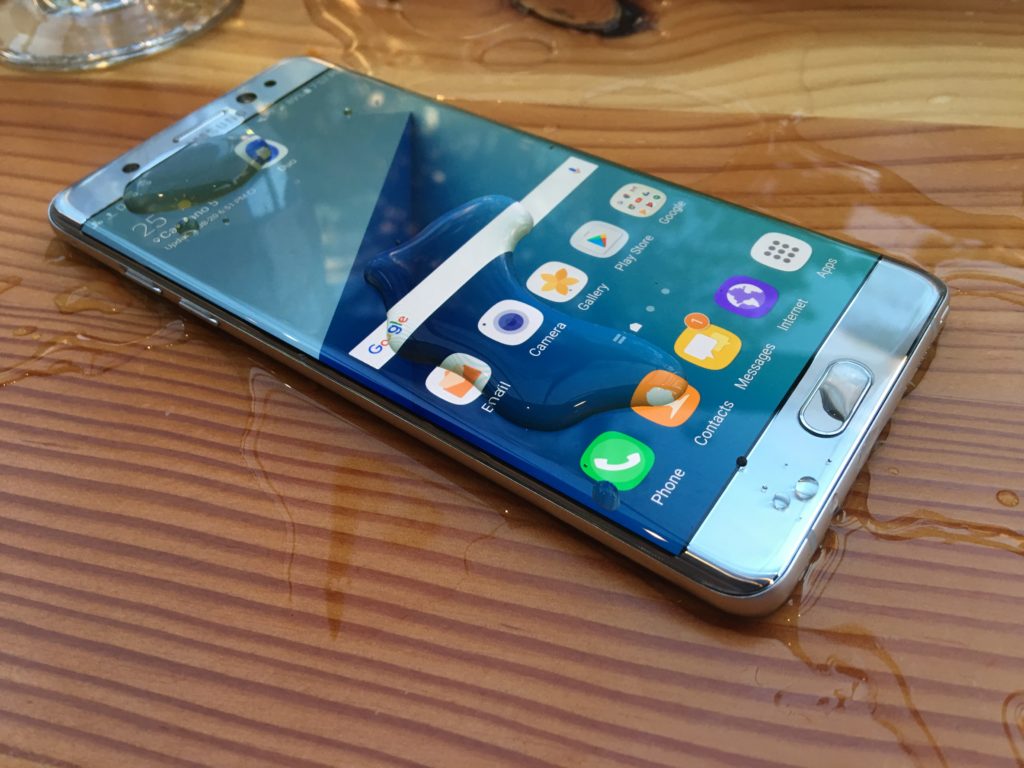
I happen to be in Seattle for a friend’s birthday pool party where a number of others had just gotten their Note 7s and a few of them ended up in the pool without fear of damage.

The Screen
As before, the screen on the Note 7 is stunning.
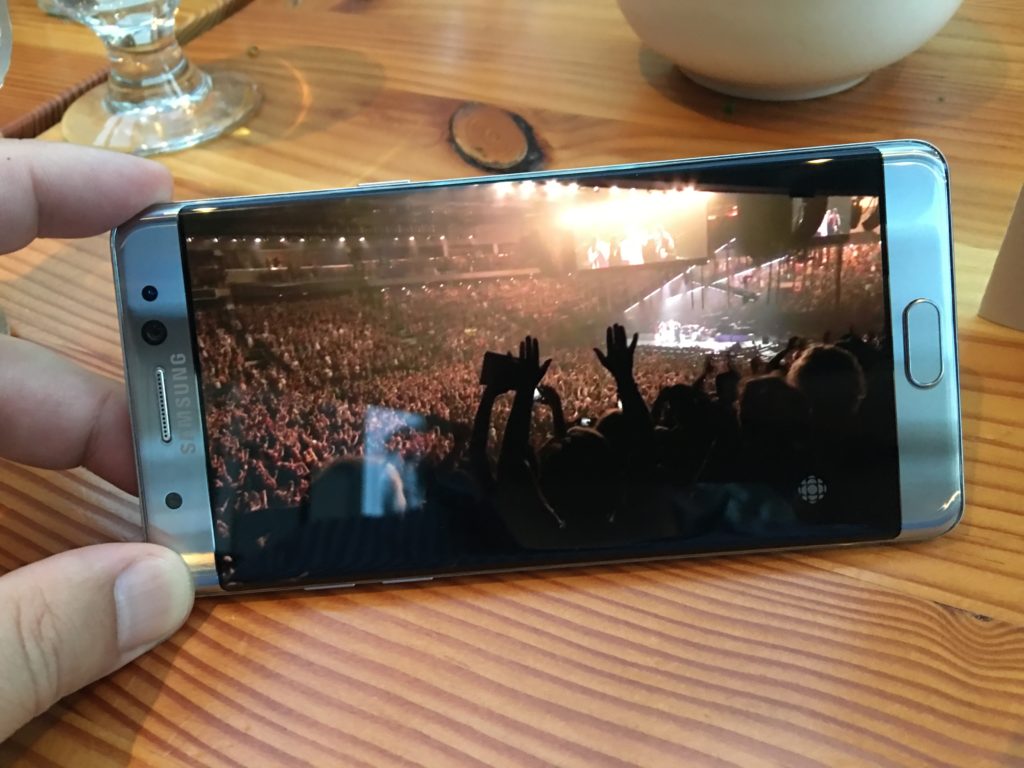
While not an ‘Edge’ device, the screen has almost no bezel as it wraps around the front of the device. The screen is actually bigger than my iPhone 6S Plus but is a physically smaller phone due to the non-existent bezel. It’s also capable of playing back HDR Video which effectively puts a 4K tv in the palm of your hand. While I didn’t have any HDR content to view on it, I did watch the final Tragically Hip concert live on CBC (on Bell’s streaming TV service) and it looked amazing from every angle:
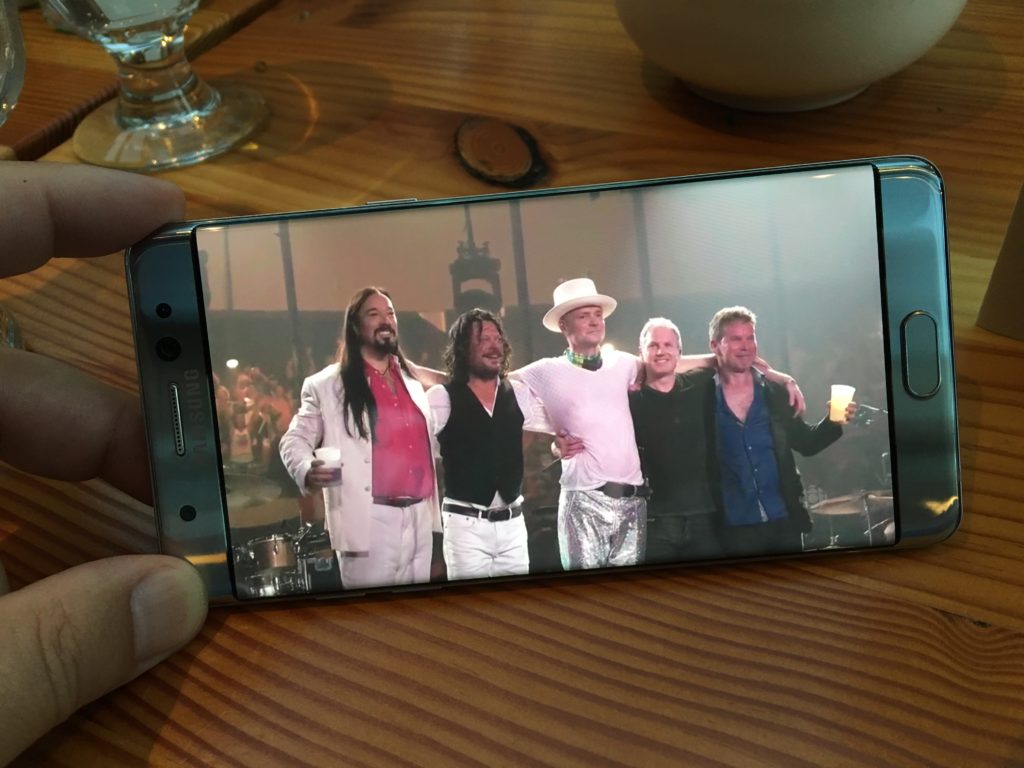
Goodbye micro-USB, hello USB-C
This was the first device I’ve had that dropped the Micro-USB port and used USB-C instead. This is basically where every device will go (except perhaps Apple) and it’s a welcome change since the plug orientation doesn’t matter. It will end fumbling around in the dark to plug in a phone with a micro-USB plug.

My review unit came with a tiny micro-USB to USB-C dongle (I didn’t get a dedicated USB-C cable) which made it easier to use with my existing cables but was almost lost a few times.
Accessories
Samsung usually comes out with a bunch of case options for each new revision. Aside from some faster (wireless) charging cases, one option that stood out was the case with a lens thread to accept a wide angle or telephoto lens. These have been available from 3rd parties for years but it’s nice to see a 1st party option to further enhance the Note 7’s great camera.

Finally, I should also mention that my review unit was the silver mirror finish. At first I wasn’t sure I’d like it but it actually grew on me and was very good at hiding my grubby fingerprints.


It really is too bad such a great Android phone is being overshadowed by the exploding battery issue which is due to a manufacturing defect.
Related Posts:
The post A few weeks with the Samsung Galaxy Note 7 appeared first on johnbiehler.com.
Why Digital Transformation Is About People
 Everyone knows the real secret to becoming a digital dominator has little to do with technology. Sure, you need rock solid tools that will enable you to move quickly, respond quickly, and stay super secure. But those tools might just sit on the shelf collecting dust unless you've got people power-driving the change.
Everyone knows the real secret to becoming a digital dominator has little to do with technology. Sure, you need rock solid tools that will enable you to move quickly, respond quickly, and stay super secure. But those tools might just sit on the shelf collecting dust unless you've got people power-driving the change.
This focus on people can be tough to swallow for lifelong technologists. Computers are binary. Code compiles or it doesn't. People have their own agendas. But computers only do what they are told. People bring creative ideas and enthusiasm, the one-two punch of successful projects.
With this in mind, let's look at three ways to induce meaningful change in your organization.
Help cure decision burnout
Executives are on the line to produce results (usually based on just a few simple metrics). If you can move one of these metrics or reduce their risk, you will get their attention. Show them how your idea solves a real, existing pain point. Demonstrate that you have thought about costs, effort, and impact to the organization. Convince them that the risk of not doing this is much greater than executing your project. After all, in today’s business environment, having a well-managed, well-designed API is like have an “open for business” sign.
Even the most capable executive is a human being, and is almost certainly suffering from decision burnout. Make their choice easy: be prepared, enthusiastic, and take some risk out of their lives.
Convince the people who need to execute that their lives will be better
You won't be able to realize your plans alone. Several teams will probably be involved, but one or two teams will do most of the work implementing the project and owning and operating it day to day afterward. Find these people and convince them that their lives will be better after the project is complete (but here's a hint: make sure this is true).
Perhaps the team is burdened with some manual tasks that will be automated. Maybe testing, monitoring, analytics, or reporting will now be easier. We've all participated in projects where every task was a chore—people just wanted to complete the spreadsheet and move on with their lives. These projects aren't fun and they don't produce spectacular results. Nobody gets promoted after one of these ordeals.
Maybe you've been lucky enough to participate in another type of project: one where the team believed in what they were building. The people couldn't wait to see the results in production. These projects fly upon golden wings. They become cherished memories that warm us during cold spells working on average projects, dreaming of the day we can spread our wings in the warm sun once again, building something meaningful with others who share the same vision.
Make sure your project is this kind of project.
Play the bongos every day
As a young man working in a large company, I used to believe that everyone else knew how hard I was working and understood my commitment and motivation.
Over time, I came to realize that they all had lives of their own. Their plates were full and they were being asked to execute on a different list of tasks. They weren't telepathic. And even if they were, they wouldn't have had time to read my mind.
My mentor taught me to bang my own drum. Not aggressively, not arrogantly, but incessantly. Keep up a steady drumbeat of why this project matters. Remind people of the little successes. Get the organization dancing to the rhythm of your project's beat. Don't assume people can read your mind. You know how important digital transformation is for your company. Don’t rest until everyone else understands this too.
Counter-intuitively, this is the secret to successful change in a large organization-- even technology-fueled change. Much like Soylent Green (but, of course, for a much different reason), it's people.
Learn about the importance of building the right API team, with the right leadership, in the new eBook "How to Build an API Program That Doesn't Suck: The Survival Guide for Digital Business."
Image: Flickr Creative Commons/Garry Knight
Information is Beautiful 7th Anniversary “Micro-Retro-Edition”
For just $1.99 US or £1.49 UK own a special retro Kindle edition of our first infographic book, Information is Beautiful. (published as the Visual Miscellaneum in the US)
We didn’t expect to be releasing this. It was just a funny experiment. Could we take a chunky visual feast of a book and distill it down to a series of black’n’white data pills?
So we started playing. And, to our surprise, it worked. It really worked.
After reworking and revisioning every single image of Information is Beautiful we discarded the many more complex infographics which didn’t hit home. Sniggered at the few that shouldn’t have converted, but did. Crunched them all down, enjoying the creative limits and odd charms of Kindle retro-tech.
(I love its smudgy 8-bitness. The grayscale. The way the previous screen ghosts-under and illuminates the next)
Actually this book might illuminate a key aspect of infography and data-visualization that is often forgotten. This is: concept. If the concept for your graphic is strong and clear, the information design doesn’t have to be complex or wall-sized or interactive – or even colourful. Better, small graphics can be slipped quietly into your mind on the train, on the bus, in the bath…
Wherever you end up reading this, I hope it tastes sweet.
David
Get the Kindle Edition for £1.49 UK / $1.99 US





Missing and murdered indigenous women inquiry coverage
Who’s attending and live-tweeting the missing and murdered indigenous women inquiry? What’s the best news source, with an RSS feed? #mmiw
— Richard Brynjólfsson (@sillygwailo) September 1, 2016
Cloud-based, end-to-end encryption file storage
What’s the @Snowden-approved, cloud-based, end-to-end encrypted file storage service (with photo gallery view)?
— Richard Brynjólfsson (@sillygwailo) September 9, 2016
Samsung Explains the Fault behind Exploding Battery in Galaxy Note 7
 Samsung has surprisingly been very transparent about the whole incident regarding batteries inside the Galaxy Note 7 exploding. Right from the get-go, the company has made announcements to keep all Note 7 customers in the loop.
Continue reading →
Samsung has surprisingly been very transparent about the whole incident regarding batteries inside the Galaxy Note 7 exploding. Right from the get-go, the company has made announcements to keep all Note 7 customers in the loop.
Continue reading →
Weeknote 36/2016
This week I’ve been:
- Sending out Issue #227 of Doug Belshaw’s Thought Shrapnel, my weekly newsletter loosely focused on education, technology, and productivity. Amongst others, it featured links on minimalism, data-sharing, and two-dimensionality. Many thanks to Makers Academy for sponsorship!
- Postponing the return of the TIDE podcast until next week. It’s been a busy start to the new academic year for co-host Dai Barnes, and we couldn’t find a time we could both make. We’re looking at shifting both recording times and the day we release the podcast each week.
- Catching up with various people, including Rosie Clayton, Dom Murphy, Phil Veal, and Sunil Rodger.
- Planning with my We Are Open colleagues ahead of the thinkathon we’re running for Creative Commons next week.
- Celebrating our 13th wedding anniversary with my wife.
- Fixing my Linux laptop. I use Elementary OS, which is based on Ubuntu. There’s a new version out today, and in preparation I had to fix some problems I had with apt-get, dpkg, and dependencies so I could install/upgrade software packages. Thank goodness for the Ubuntu forums and helpful people who document solutions!
- Liaising with various people about the UK digital co-ops retreat we’re helping organise at Wortley Hall (near Sheffield) in November.
- Facilitating a planning day (along with Bryan Mathers) for London CLC.
- Signing up for hotdesking at Campus North, after I realised I should spend one guaranteed day based out of my home office each week!
- Transferring my ebook to Gitbook (nearly finished!) More on this soon. I was inspired by what Albert Wenger has done with World After Capital.
- Starting going to Pilates again.
- Getting back in the swing of family life during term-time. Our eldest is now at middle school so is walking to school by himself.
- Spending much less time on Twitter and Slack in an effort to focus on the important stuff I needed to get done.
-
Writing a lot more than usual because of the above point. In addition to those linked below, I also drafted a new post for DML Central:
- Not courage, but leverage (8th September 2016)
- Igniting my Mondays (8th September 2016)
- We’re preparing kids all wrong (8th September 2016)
- 5 reasons your business should employ remote workers (8th September 2016)
- Turning pro (8th September 2016)
- Less side-hustles, more hobbies please (7th September 2016)
- The bias against alternative organisational structures (7th September 2016)
- Why you should write a to-do list every morning (7th September 2016)
- MOOCs aren’t ‘massive’ just because they have lots of people taking them (6th September 2016)
- Other people aren’t there to tell you what to do (5th September 2016)
- Philosophy always wins (5th September 2016)
- Nassim Nicholas Taleb on ’employability’ (5th September 2016)
- Increasing your ‘serendipity surface’ (4th September 2016)
- Hidden privilege (4th September 2016)
- Should I keep encouraging my kids to do team sports? (4th September 2016)
- How to avoid Seasonal Affective Disorder (SAD) (3rd September 2016)
Next week I’ll be in Newcastle and then Gateshead on Monday, working from home on Tuesday, in Sunderland on Wednesday, working from home on Thursday, and then pottering about during my Friday ‘Doug Day’. I’d still really like to get down to London for Futurefest next weekend as it was excellent last year…
Image CC BY-NC-SA Jonathon Hurley
Wikipedia and the Anti-Semites
Wikipedia has read me out of meeting because I restored the following passage that an anonymous troll had blanked in Wikipedia’s article about an Alt-Right chat board. These Internet sites became a focus of international attention last July, after Donald Trump tweeted an image of Hilary Clinton, a Star of David, and a sea of dollar bills that he had seen on a white-supremacist board. The passage I restored read as follows:
Anti-Semitism and White Nationalism
In July of 2016, US presidential candidate [[Donald Trump]] tweeted an image of Hillary Clinton with a background of money and a six pointed star, seen by some as resembling the Star of David containing the message "Most corrupt candidate ever". The image had originally been posted to 8chan's /pol/ board. The New York Times called 8chan a "website for the 'alt right,' an internet-based movement associated with white nationalism." [1] [2]
Scrubbing even this timid and tentative report from Wikipedia is Orwellian.
I no longer support the project to which I have given so much time, but I do occasionally glance at selected pages for two reasons. The first is safety. For example, one of my former Wikipedia opponents was recently detained and held without bail. (He’s out now, and on Twitter he’s talking about the “Jewish overlords” who run Broadway. Great.)
The second reason is to assist people seeking legislative and regulatory solutions to the menace that Wikipedia has become. A solution must be found for Wikipedia’s promotion of harassment – especially of women and Jews – and for its encouragement of extortion.
Still, as I pass through those dusty corridors, it seems churlish to simply ignore typos, vandalism, and other rubbish that can easily be fixed. They don’t want me to edit Gamergate; apparently, that extends to the entirety of the alt-right takeover of the Republican Party and, if they have their way, our country.
My Watershed Moments
The idea is to identify some key events in our own professional development, some 'watershed moments', if you will. Shareski writes, "Watershed moments are those occasions where there the lightbulb came on or something profound was shared or understood."
These are my own, and I'll use the same categories they do.

PD / Conference
I've had a number of key events in my professional life; most of the core ideas of my own approach to education and technology have been formed while on the road. On a trip through Australia in 2004, for example, I was inspired by Olegas Truchanas in Strahan, to think of teaching as stewardship and by the Aboriginal cave drawings in Kakadu to understand that we read the world. Or for example my visit to South Africa where I encountered the cattle boys of Lesotho, or how I learned about groups and networks in New Zealand. The list goes on.
But if I had to identify one conference that was an eye-opening moment for me, it would be my visit to Bogota in July, 2006. I gave two talks, both on the subject of learning objkects and learning object repositories, at a conference titled Objetos de Aprendizaje (OA) y Redes de Alta Velocidad held at the Escuela Colombiana de Ingenieria.
It was my first time in Latin America and my first time outside the western world. I didn't learn so much about learning objects and such as I did people's attitudes towards learning and development outside my own culture. I saw a modern and technologically advanced school, met with staff and students who were knowledgeable and eager to build something better, and I saw a city and a culture ion what can only be described as a springtime for the country.
If affected me so deeply I made a movie about it, spending the next four weeks after the visit learning video editing and painstakingly piecing it bit by bit on a machine vastly underpowered for the job. It recounted not so much my experience at the conference - though it did cover that - as it did my experience in the streets, walking and talking with Diego Leal, talking about learning, seeing and feeling the powerful juxtaposition of people who have everything and people who have nothing, and how to bring them together.
"It all comes back to the children. What they see. What examples they follow. What they learn to value. What they see in life. Diego and I talked about this as we wandered through the Candelaria. That learning isn't saying the right thing or presenting the right content. It's doing the right thing and living the right way. And that's the learning that I was seeing in the park in Bogota that day."
Presentation
As I would write later: "In 1989, the pieces came together. I watched the rise of 'people power' around the world. I had seen Francisco Varela speak on AIDS and immunology at the University of Alberta hospital. I began to see how networks, whether of individuals of cells, could take shape, form patterns, act with purpose. And how this would reshape how we understood the world."
It's hard to explain why this talk in particular had such a profound effect on me. I'm not sure there is any extant record of it , except for what might be in my own notes. The technical part of the talk was an explanation of how the immune system and the nervous system had in common the property of being a network. He was explaining how the entities in these networks communicated. And he identified a 'sweet spot' - not too many connections, not too few - that would enable optimum functionality.
I knew about connectionism by then - that was why I was in the room - and I had been working on a network theory of knowledge. This talks emphasized to me that there were ways to understand networks themselves that would be of interest, and of use, to this understanding.
But there was more to Varela than that. It's when you look deeply at a person who is presenting and you see the resonance not just of superficial theory but of a way of seeing the world. That's also what I saw that day. A few weeks later I would write my entire dissertation in just a few days sitting on the top of a hill listening to folk music.
"If everybody would agree that their current reality is A reality, and that what we essentially share is our capacity for constructing a reality, then perhaps we could all agree on a meta-agreement for computing a reality that would mean survival and dignity for everyone on the planet, rather than each group being sold on a particular way of doing things." - Varela.
Book
I've had the privilege of reading a large number of powerful books in my lifetime. Some - like Patrick Watson's The Struggle for Democracy, Kenneth Clark's Civilisation or Carl Sagan's Cosmos - were born as TV shows. Others, though, were the classics of literature and philosophy - Tolstoy's War and Peace is probably the greatest book I've read, while Gibbon's Decline and Fall much be the most vital nonfiction, followed by Shirer's Rise and Fall of the Third Reich.
But the watershed moment for me comes with the reading of John Stuart Mill's On Liberty.
I read it in the Devonian Gardens in downtown Calgary around 1983 or 1984. The gardens are actually indoors, occupying the fourth and top floor of a downtown mall in TD Place. They were as large as a city block, fully tropical, and filled with nooks and crannies where someone could hide and read. Which is what I did. It was the beginning of a habit, for me, of reading great works of philosophy in malls and gardens.,
What Mill said two me was twofold: first, that every person has as much inherent dignity, worth and capacity as every other person, and that they are held back only by circumstances of poverty, poor education, or some other form of oppression; and second, the only defensible definition of society was one in which each person is free to pursue his or her own good, in their own way, so long as it doesn't interfere with others' rights to do the same.
Now of course the latter part of Mill's dictum has been taken on by neoliberals to justify some sort of libertarian non-society, but both parts of Mill's thesis are essential, and no view of society that treats its subjects simply as means (as Kant would say) to someone else's ends is worth defending. There is a type of freedom that Mill envisioned which is essentially one of stepping lightly through the world, redressing wrongs, and working for the betterment of oneself and one's fellows.
Public gardens, I find, are the perfect place to read enlightened philosophy.
Tool
I am tempted to write 'the computer' or 'the internet' here. But I'll be more specific.
NCSA's Mosaic was the first graphical we browser. It transformed the web from a linear text-based environment to a non-linear link-and-graphics based environment. It's hard to describe the impact of that.
Before Mosaic, I actually had my feet firmly planted in both worlds. By the time it came out in 1993 I had had several years of internet experience, building bulletin boards systems, programming multi-user games, and traversing the depths of FTP, Usenet and email. And I also had a history in graphic design, working first with wax-and-paper based layout and design, and then tools like Quark xPress, to create pages, posters and more. I had even authored a guide, Practical Graphic Design.
The resulting fusion of those technologies enabled my two greatest passions: to create, and to explore. I began building web sites almost immediately. And I began to navigate the world by hyperlink, spending thousands of hours exploring tens of thousands of websites, peering into minds and lives I never knew could possibly exist.
And I never stopped. My career today is an extension of these two passions, and if I would be said to have a research method, it is the same: to create, and to explore. Returning to a world bound by linear and physical limitations has never been an option.
Person
Rik Hall. You may never have heard of him, but he was of fundamental importance to me.
Rik was moderator of the online WWWDEV mailing list (archives no longer extant, because who cares about history?) and chaired the NAWeb conference in Fredericton for ten years, 1995-2005. I attended seven or eight of them, often financially supported by the conference, as an unknown academic who could do workshops on interesting topics. I also managed the NAWeb Awards for a number of years, then gave it up so I could win some, and was the keynote speaker in the tenth and final year.
I remember one time when Rik was introducing me to someone else him describing me as "one of the good ones." He didn't mean 'good' in the sense of capable, skilled or qualified, but rather, 'good' in the sense of working for the betterment of others and advancement of learning. You never saw these traits more clearly than in Rik, and it was high praise that made me glow inside but also engaged me with a sense of mission.
Through Rik I met people like Terry Anderson and Rory McGreal, who were also both important influences and role models for me. He also connected me with a etwork of developers and inventors. And NAWeb was leading edge - I connected to wireless internet for the first time at NAWeb. NAWeb connected me to AusWeb (where I did my first video editing in 2001) and with a number of great people from Down Under.
Rik is a sharer, a connector, and a demonstrator. He encouraged me when I explored with RSS and content syndication, he taught me to look for and appreciate the best in the many people around the world working in education, and he linked me to a community I had hitherto not even known existed. Like the best of them, he taught through example and not though lecture, and one of the many people he increased in life was me.
"Hope locates itself in the premises that we don’t know what will happen and that in the spaciousness..."
-
Rebecca Solnit, ‘Hope is an embrace of the unknown’: Rebecca Solnit on living in dark times
Hope is an embrace of the unknown and the unknowable.
The world, then, is divided into three, not two; not just the optimists versus the pessimists in an endless argument of up and down, right and wrong, in and out. There are three, and the third are those that hope, who hold out against despair and disengagement, even in the darkest days.
'Star Trek' Turns 50: Here Are 6 GIFs, the Final Frontier
50 years ago yesterday, television viewers across these United States begane to explore "the final frontier," thanks to the prophetic genius of Star Trek creator Gene Roddenberry. Star Trek's influence is difficult to quantify. Its gadgets helped inspire researchers to invent the cell phone, virtual reality, and more recently, transparent aluminum. The show broadcast the first interracial kiss on television. Trekkies arguably did as much for fandom as Star Wars obsessives, and it was the first subculture listed in the Oxford English Dictionary.
But—obviously—more important than any of that stuff is the show's effect on GIF artists. Star Trek reaction GIFs abound, but the original work by animators like Scorpion Dagger and Victor Courtright are pure gold. Let the shiny molten goodness of this week's GIF Six-Pack wash over you as you celebrate five decades of living long and prospering.
See more Star Trek GIFs on GIPHY.
Related:
How to Create the 'Star Trek' Teleporter Effect for Your Own Sci-Fi Film
Inspired By Star Trek, Artists Create A "Teleportation" Installation
Graffiti Exposes the Hypocrisy of Setting Brock Turner, Rapist, Free | Insta of the Week
A photo posted by Plastic Jesus® - Official (@plasticjesus) on
Last week Stanford University student and convicted rapist Brock Turner was freed from prison after just three months, one-half of the already lenient sentence that has sparked international outrage for months now. On Tuesday, he registered as a sex offender in his home state of Ohio, and since then, violent protestors outside his house have kept his name in the news cycle.
LA street artist Plastic Jesus—recently known for erecting a tiny wall around Donald Trump's Hollywood star—framed the weak justice that was Turner's sentence in a way that will make both creatives and urbanists cringe. "I was gonna paint some street art on this electrical box, but I realised I could go to jail for longer than a rapist," he stenciled onto an electrical box posted to Instagram on Tuesday. In the description he explains, "Streetart [sic] is considered criminal vandalism. If damage exceeds $400 it is a felony with up to 3 years jail time. Below $400 is misdemeanor 1 year jail time. And let's be honest if the city send out one guy with a pot of paint and a brush they are gonna cost it at more than $400." If prosecuted to the full extent of the law in some states, Plastic Jesus would end up in jail for longer than Turner did for forcing sex on an unconscious woman behind a dumpster.
Last night Plastic Jesus posted a second stencil, to the same effect as Tuesday's, but on a wall:
A photo posted by Plastic Jesus® - Official (@plasticjesus) on
The outrage has prompted California to pass a law enforcing mandatory minimum sentences for sexually assaulting an unconscious person. According to a statement issued by Santa Clara County District Attorney Jeff Rosen, Assembly Bill 2888 is designed, "to make sure the next Brock Turner either leaves the next Emily Doe alone, or the next Brock Turner goes to prison,” though there has been some controversy about whether this law is the best way to solve the problem. Plastic Jesus' words capture his rage against the mishandling of Turner's case and the legal system's leniency towards rapists of a certain privilege, but it also embodies the legacy of bad laws written out of fear and manipulated public opinion.
Find more from Plastic Jesus here, and follow The Creators Project on Instagram to find your next favorite artist.
Related:
[NSFW] The Graffiti Artist Who Painted a Naked Eric Andre Mural...Naked
Graffiti Artist Hides a Mural in 100 Illegal Tags
What Happens When a Six-Year-Old Piece of Street Art Goes Viral?
Friday Funny – No Need for Fancy Names
This image comes courtesy of local artist Artistically_Unstable:

“No need for fancy names. This is what every new residential tower in Vancouver should be named these days.” – Artistically_Unstable
AU’s work is very punny, set in Vancouver, and uses the medium of doodling as a method of injecting a few harmless and nostalgic laughs into a rainy west coast afternoon. If you are interested in AU’s work you can refer to his Instagram.
Bike the Night – Sep 16
Experience the beauty and energy of nocturnal Vancouver at its best – by bike. As dusk becomes darkness on September 16th, join thousands of people on bikes and pedal the streets of Kitsilano and Shaughnessy, as well as along the new Arbutus Greenway. Help support HUB’s work to make biking better while having an awesome time. The car-free and easy route make this an ideal evening activity.
Tickets start at just $10! View the full rate chart here.

Item from Ian: Right Bank, Right Choice

It is 8.30am on a weekday rush hour and the Voie Georges-Pompidou along the right bank of the Seine, normally one of the busiest highways in Paris, is eerily quiet.
Around 43,000 vehicles a day used this expressway, built in 1967, to cross central Paris from west to east, but they are nowhere to be seen. Instead, teams of workers are there, planning playgrounds, wooden terraces, waterside gardens restaurants and rectangular terrains for playing boules.
The drone from traffic on the parallel Quai des Celestins, higher up the river bank, suggests traffic there is moving along at a respectable pace – confounding those doomsayers who suggested the controversial scheme to pedestrianise two miles of city centre highway would bring neighbouring roads to a standstill.
While this section of the Seine closes every summer to host the Paris Plages – in which temporary artificial beaches are created along the right bank of the river – this time the expressway has not been reopened.
Instead Paris’s prefect of police – the state representative – this week approved the closure of the riverside route for a six-month trial. Socialist-run city hall says it intends to keep the highway closed to vehicles for good. …
Few issues have so bitterly divided Parisians than the closure of Voie Georges-Pompidou. The move, one of the pillars of Hidalgo’s 2014 election campaign, has pitted city hall against the regional council, right against left, motorists against pedestrians, in increasingly bad tempered exchanges. …
Christophe Najdovski, Paris deputy mayor responsible for transport and public spaces, and a member of the Ecology Green party, said the new project is all about changing attitudes. “The first few weeks will be difficult and then it will become normal. As we have seen with this type of project across the whole world, including places like New York and Rio, is that when an urban highway is transformed or closed, there is an evaporation of traffic. Either people modify their route, or they use their car less and take other forms of transport.
“Behaviour will change. Habits will change. And our objective, to reduce traffic and thus pollution, will be achieved.”
Najdovski added: “We have done all studies necessary for this project and we’re convinced that after six months, a year, everything will be fine and nobody will be talking about this any more. That’s what happened with the right bank three years ago.

But Pierre Chasseray of the organisation 40 Millions d’automobilistes (40 Million Motorists), which has 320,000 members, said Najdovski’s arguments are “utter rubbish”.
“If Anne Hidalgo wants to ride a bicycle then that’s up to her, but why should motorists suffer? Let’s make no mistake, her goal is purely electoral and this stupid idea will please two or three bobos (bourgeois-bohemians) and upset 10 million others. She doesn’t care about the people in the banlieues [suburbs] because they don’t vote for her.”
“If you close a major road, it’s obvious the cars aren’t just going to disappear. Anne Hidalgo isn’t David Copperfield. They’re going to turn up elsewhere and there will be traffic jams elsewhere,” Chasseray told the Guardian.
He added: “City hall wants to change people’s habits by force, but we’re not a dictatorship. Instead of closing the highways, they should find a way for cars and pedestrians to coexist.”
The Ile-de-France regional president Valérie Pécresse, of the opposition centre-right Les Republicains (LR) party, said the trial should last a year to take account of “spikes in pollution” in summer months. She said the pedestrianisation project was “seductive” but added: “It all comes down to how it’s done.”
“Paris cannot take brutal decision without real consultation and without taking into account the impact on the banlieue,” Pecresse told Le Monde.
Ohrn Image(s) — Public Art
Queen Elizabeth Park is home to a delightful piece of new sculpture. You can find it west of the big “Quarry Garden” bowl (one of Vancouver’s significant treasures).
Artist Bruce Voyce calls it “Love In the Rain“.
It’s four sets of embracing, dancing figures, under umbrellas, built mostly with curved metal tubes, perfect for attaching a “love lock“. It’s whimsical, charming, practical and fun — all at the same time. Oh yes, and on a large concrete base, anticipating the weight of locks to come.





Artist Profile: Bruce Voyce

Bruce is a well-known and highly celebrated artist residing in the Strathcona neighbourhood in Vancouver. Since 2005 he has collaborated with many Lower Mainland municipalities to produce site specific public art works. Additionally his work has animated public spaces as far away as Japan.
More about the process at the Parks Board HERE.















